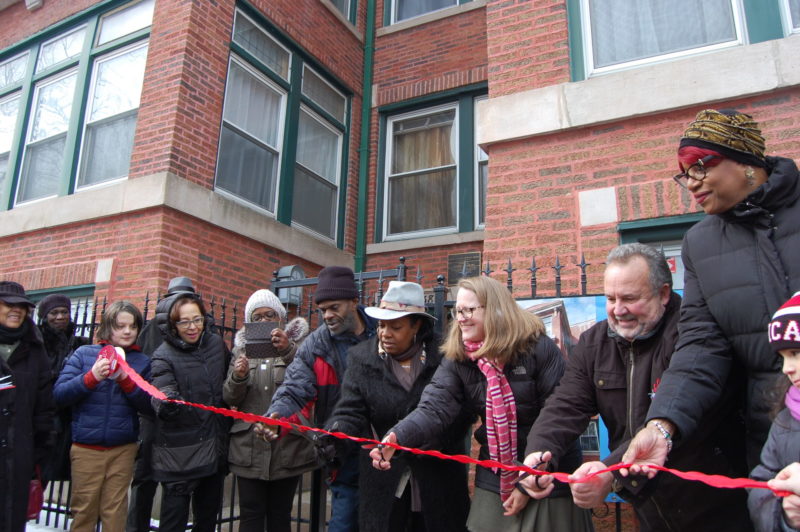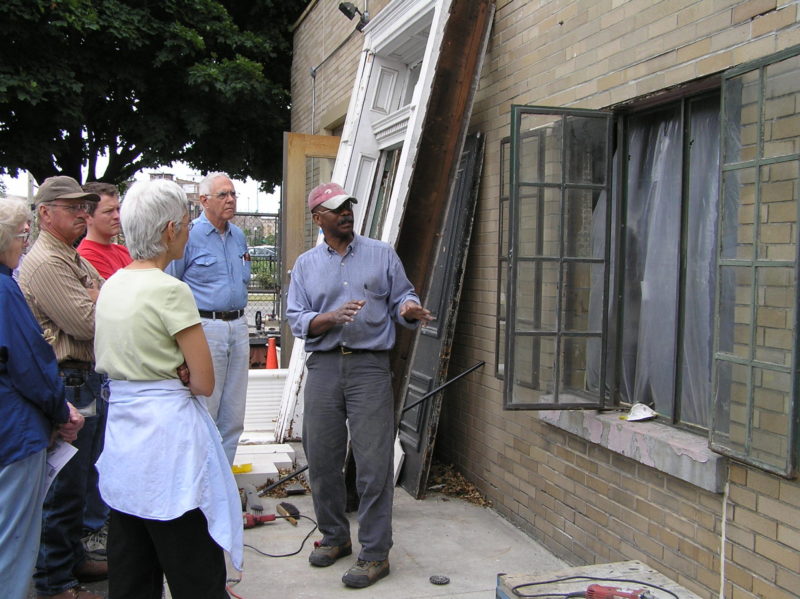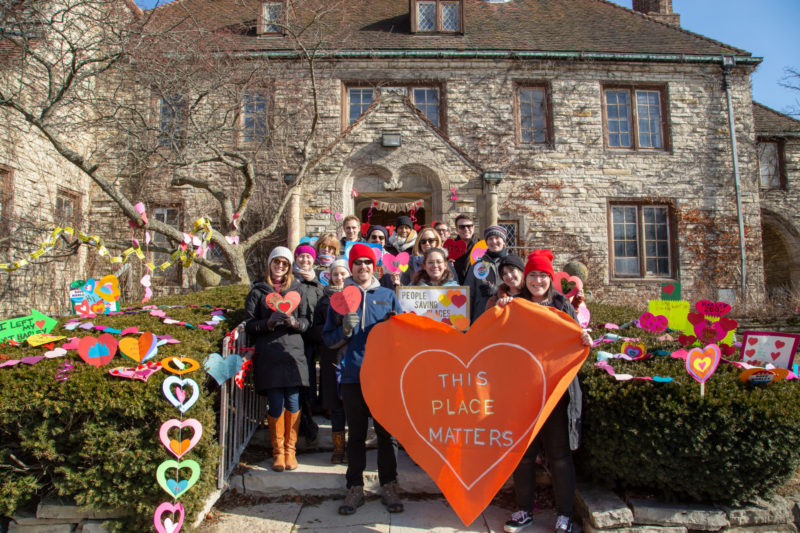OUR MOST FREQUENTLY ASKED QUESTIONS
Have a question on historic preservation, easements, landmarks or how to get involved in our organization? Landmarks Illinois preservation experts provide detailed answers to our most commonly heard questions.
Have a question on historic preservation, easements, landmarks or how to get involved in our organization? Landmarks Illinois preservation experts provide detailed answers to our most commonly heard questions.

Traditionally, “historic landmark” has often referred to places with an official landmark designation, whether via a local municipal designation or the National Register of Historic Places. This means a governing body has decided a place is significant and worthy of protection. At Landmarks Illinois, we take a more expansive view. Many places that hold value to a community have no formal designation but are referred to as landmarks. We agree with this inclusive view of historic landmarks and are committed to the research, recognition, designation and preservation of these important places.
At Landmarks Illinois, we believe historic preservation is best described though our mission of people saving places for people. Historic preservation is the act of conservation and protection of these buildings, sites, objects and landscapes that are significant to our personal or shared stories. In action, this looks like:
There are multiple resources available to the public to find designated landmarks in Illinois.
The best way to learn if your property has any existing landmark designation at the local or federal level, inquire with your local planning department. For example, residents of the City of Chicago should contact the Chicago Department of Planning and Development. You can also use the city’s zoning map, which indicates all historic designations under the zoning tab. Other resources:
There are various ways a property can be deemed a landmark: listing in the National Register of Historic Places, designated a National Historic Landmark or designated a local landmark. Each of these designations has a different level of protection and distinction.
National Historic Landmark and National Register of Historic Places listing are purely honorific offering no protection to the property unless federal funds are used.
Designation as a local landmark or contributing to a local landmark district offers protection through a local historic preservation ordinance. These ordinances vary and are specific to each community.
Landmark designation for a historic property or district is administered at a local municipal level if the local municipality has a historic preservation ordinance. To find out if your local government has a historic preservation ordinance, contact the local department of planning office (city, village or county) or determine if it is a Certified Local Government (CLG), which is a local government with a historic preservation ordinance that has been certified by the State Historic Preservation Office (SHPO).
Properties can also be listed in the National Register of Historic Places (a federal program of the National Park Service) and the nomination process is administered by the state’s historic preservation office. To determine if your historic property is eligible for listing in the National Register of Historic Places, follow the preliminary evaluation process as instructed on the Illinois SHPO website.
If a property is included in a historic district, designated at the local level or to the National Register of Historic Places, previous changes to a property do not need to be reversed. Only future alterations to the property (generally exterior) may require review by the local historic preservation commission. If a property in Illinois is located in a National Register district, future alterations (exterior and interior) will be reviewed by the Illinois SHPO if an owner chooses to utilize a financial rehabilitation incentive or if an owner is using federal or state funds/permitting to alter the property.
Landmark designation at the local level (individually or in a district) may provide a property owner the opportunity to utilize local financial incentives for rehabilitation. The local department of planning office or local historic preservation commission (HPC) can provide this information.
Listing in the National Register of Historic Places (individually or in a district) provides the opportunity to utilize financial incentives for qualified rehabilitations. These programs are administered by the IL SHPO.
LOCAL LANDMARK: A local landmark is a designated property, building, site or structure that has been deemed important by a local governing body. It must meet certain criteria identified in a local historic preservation ordinance to be deemed eligible for designation as a local landmark or to be included in a local historic district.
Local landmarking can be an effective tool to preserve significant places and areas within a community and preserve the unique character and history of a city, town, neighborhood or individual place. See an example of the local landmarking process at the City of Chicago’s website. Local landmark designation generally provides protection for historic buildings from future demolition or alternations that could compromise the historic character, design or integrity of a building. Restrictions and regulatory oversight of locally landmarked properties varies by community based on its historic preservation ordinance.
NATIONAL LANDMARK: A national landmark can be one of several designations bestowed by the National Park Service. See the answer to the question below.
NATIONAL HISTORIC LANDMARK: A national historic landmark is a historic place that holds national significance because it illustrates the heritage of the United States, according to the National Park Service. National Historic Landmarks, or NHLs, can be buildings, sites, structures, objects and districts. There are approximately 2,600 NHLs in the United States, 87 of which are in Illinois.
NATIONAL REGISTER OF HISTORIC PLACES: The National Register of Historic Places is the official list of our country’s historic buildings, districts, sites, structures and objects worthy of preservation. Properties on the National Register are primarily of state and local significance. The National Register was established as part of the National Historic Preservation Act of 1966 and is overseen by the National Park Service. A property must be listed on the National Register of Historic Places to be eligible for Federal Historic Preservation Tax Incentives program, a vital incentive for the rehabilitation and reuse of historic buildings. Learn more at the NPS website.
Some studies have shown that local landmark designation, particularly designation of a historic district, can stabilize or increase property values due to the desirability of living in a neighborhood where owners are highly invested in their historic properties, in turn contributing to the neighborhood’s desirability. However, landmark designation ultimately has less impact on one’s property value or property taxes than other local factors, such as zoning, safety, access to good schools and other amenities. Local historic preservation ordinances differ in their level of protection and oversight. Local rehabilitation incentives made available in a community differ as well, which may or may not impact property values or property taxes of designated properties.
Generally, National Register designation will have no impact on property values or property taxes due to the fact that its designation is only honorific and National Register-listed properties can be altered or demolished. (Regulatory review of a threatened National Register-listed property only occurs by the state’s historic preservation office if federal or state funds or permits are involved in the action threatening the property).See the following studies addressing property values:
An owner of a historic property may choose to donate a preservation easement to a qualified historic preservation organization, such as Landmarks Illinois, which provides protection of that property in perpetuity. This level of protection can lower one’s property value and in turn, the donor may seek a federal tax deduction for the easement donation. See below for definition of a preservation easement.
A preservation easement is a legal agreement between a property owner and a qualified easement-holding organization that protects a significant historic or cultural resource in perpetuity. Preservation easements are recognized as the strongest and only perpetual protection available for historic properties. Landmarks Illinois protects nearly 550 historic properties through preservation easements. For more information, click here.
Landmarks Illinois protects nearly 550 historic properties across the state with preservation easements.
If you are interested in donating a preservation easement, please review our donations procedures document. You can also reach out to Suzanne Germann, Director of Grants and Easements, at (312) 922-1742 or email for more information.
Owners of properties protected by a preservation easement are required to obtain the approval of Landmarks Illinois before making alterations to the protected elements of the property. Please contact Landmarks Illinois prior to commencement of any work to ensure that proposed maintenance and alterations are in accordance with the easement agreement. If necessary, you will need to complete a Request for Alterations Form. You can also contact Suzanne Germann, Director of Grants and Easements, at (312) 922-1742 or email for more information.
The seller of the property is required to notify Landmarks Illinois in writing of any proposed sale of the property and provide the opportunity for Landmarks Illinois to explain the terms of the easement to potential new owners prior to sale closing. We encourage the seller to alert their realtor and any potential buyer about the easement.

Landmarks Illinois’ Restoration Resource Directory provides property owners and design professionals with access to professional services, products, craftspeople and other experts related to the maintenance, restoration and rehabilitation of older structures.
Please note that this directory is not intended to be comprehensive or an endorsement – it is for your convenience. Omission from the list does not imply that a provider is unqualified. Inclusion in the list does not verify the provider’s qualifications, experience or ability. Landmarks Illinois recommends that you request and check references before hiring any service provider.
Rehabilitation is often comparable in cost or less expensive than new construction, especially if the new construction includes demolition costs. In addition to individual costs for a project, building rehabilitation and reuse has been documented to catalyze local economic development and improve job creation, property values, heritage tourism and neighborhood revitalization. For more information, please see the report, “Measuring the Economic Impacts of Preservation: Recent Findings.”
Landmarks Illinois has three grant programs available to nonprofit organizations or governmental bodies for their preservation projects: The Preservation Heritage Fund Grant Program and the Barbara C. and Thomas E. Donnelley II Preservation Fund for Illinois and the Timuel D. Black, Jr. Fund for the Chicago’s South Side. Learn about Landmarks Illinois’ grant programs here. You can also click here for a list of grants and incentives available through other organizations.
There are several state and federal programs available to historic property owners. For instance, the Illinois Historic Preservation Tax Credit Program provides a state income-tax credit equal to 25% of a project’s Qualified Rehabilitation Expenditures (QREs), not to exceed $3 million, to owners of certified historic structures who undertake certified rehabilitation projects. More information on the Illinois Historic Tax Credit Program is available on the Illinois State Historic Preservation Office’s website.
Information on these programs and many more other financial incentives is also available on our Financial Resources webpage.
In addition, historic property owners should contact their local government for any local programs or incentives for historic property owners.
For all programs, we encourage owners to contact the program administrators for more information prior to beginning work on a project.
The windows on many historic buildings are an important aspect of the architectural character of those buildings. Their design, craftsmanship or other qualities may make them worthy of preservation. The California State Parks Office of Historic Preservation provides the most thorough evaluation of the historic window topic including studies and research.
Beyond the historic integrity of a building, energy efficiency is a concern when it comes to windows. To understand more, read The National Trust for Historic Preservation’s Preservation Green Lab report “Evaluating the Energy Performance of Window Retrofit and Replacement,” which provides data on the topic.
For those considering restoring their windows, the National Park Service Preservation Brief: The Repair of Historic Wooden Windows is a good resource.
If you are looking for a professional to restore your windows or custom build an appropriate replacement or storm window, check our Illinois Restoration Resources Directory.

Landmarks Illinois is a membership-based nonprofit organization serving the people of Illinois. We inspire and empower stakeholders to save places that matter to them by providing free guidance, practical and financial resources and access to strategic partnerships. Click here for more information on Landmarks Illinois.
No. Landmarks Illinois is a private, not-for-profit organization. Our annual revenue is comprised of donations from individuals, foundations and corporations (95%) and earned income (5%). The state historic preservation agency is the Illinois State Historic Preservation Office, which is part of the Illinois Historic Division of the Illinois Department of Natural Resources. Visit the state’s website here.
No. While we do help people in Illinois through the designation process, Landmarks Illinois itself does not have authority to landmark properties. However, Landmarks Illinois does hold preservation easements that protect historic properties through an owner’s donation of that preservation easement. A preservation easement is a legal agreement between a property owner and a qualified easement-holding organization that protects a significant historic or cultural resource in perpetuity. For more information, click here.
Landmarks Illinois’ main office is located in Chicago. We also have regional staff around the state, like our Regional Advocacy Manager Quinn Adamowski in Joliet, who travels throughout Greater Illinois to meet with local advocates and communities outside Chicagoland. Learn how to contact staff at each office here.
Landmarks Illinois works all across the state. We are here to help people in every community save the historic places that are unique and special to them. Our staff is available via phone and email to answer questions and provide assistance and resources and also travels throughout the state to meet in person with community advocates and organizations and local and state officials.
Every year, Landmarks Illinois engages an increasing number of communities throughout Illinois in preservation-related efforts. This map illustrates the more than 100 places where Landmarks Illinois has made site visits, given assistance, listed properties on its Most Endangered Historic Places in Illinois list, awarded grants and presented our Richard H. Driehaus Foundation Preservation Awards in the past fiscal year (July 1, 2015-June 30, 2016).
Every year in the spring, Landmarks Illinois releases its Most Endangered Historic Places in Illinois. It is a list of historic sites throughout the state most threatened by deterioration, lack of maintenance, insufficient funds or inappropriate development. The annual list aims to do the following:
Landmarks Illinois first published its Most Endangered Historic Places in Illinois in 1995. In 2019, we commemorated the 25th anniversary of the program. Learn more about the Most Endangered Historic Places in Illinois here.
In addition to the headquarters office in Chicago, Landmarks Illinois has a regional office in Springfield in shared space with the State Historic Preservation Office, Department of Natural Resources. This proximity benefits Landmarks Illinois’ access to key governmental programs, including the National Register of Historic Places, historic tax credits and regulatory review.
Landmarks Illinois works with a network of Regional Advisors throughout the state to provide consultation on projects and information on emerging issues.
For any project or initiative, Landmarks Illinois is often working closely with a network of local and regional organizations. We have a large network throughout the state which we continually are working to grow. Examples include local advocacy organizations and preservation commissions, regional initiatives like the Abraham Lincoln National Heritage Area and the Route 66 Scenic Byway, and statewide programs like Illinois Main Street.

Inquire with your local department of planning office if there are positions available on the local historic preservation commission or volunteer opportunities to help with the Commission’s educational outreach. Many communities have local historic preservation or “friends” organizations, historical societies or civic groups that are focused on the identification and protection of historic places and sound community planning. Inquire with local planning department staff or the Historic Preservation Commission chair regarding opportunities to be involved. You may also reach out to Landmarks Illinois’ statewide Regional Advisors to inquire about ways to be involved. Finally, join Landmarks Illinois to learn about preservation efforts in your area and the entire state.
Landmarks Illinois members are individuals, companies and organizations which have chosen to make a membership contribution to the organization and receive the corresponding benefits. Individual memberships begin at $35 a year. Landmarks Illinois’ Sustaining Partners Monthly Giving Program allows you to make automatic, recurring monthly contributions to the organization in lieu of an annual, one-time membership contribution. Professional memberships are also available for companies and firms. Landmarks Illinois could not accomplish its work without the support of all our members, donors and volunteers!
You should become a member of Landmarks Illinois if you believe in the beauty, functionality and value preservation and adaptive reuse brings to the places that anchor our neighborhoods, making them authentic and unique.
For nearly 50 years, Landmarks Illinois has worked to help communities and neighborhoods throughout Illinois preserve and protect their architecture and historic places. We fulfill this important mission through advocacy, education and public awareness programs, legislative initiatives, technical assistance and grants. We also work directly with local preservation groups, state agencies, historic commissions and owners of historic buildings to find solutions to historic preservation issues.
Without a strong statewide advocate for historic preservation, our unique and irreplaceable heritage would be squandered. Our work enhances communities, empowers citizens and catalyzes local economic development statewide.
Become a member of Landmarks Illinois’ Skyline Council, Landmarks Illinois’ committee of young professionals. It consists of more than 30 emerging leaders with an interest in historic preservation, the built environment and healthy communities. Through service, social engagement and advocacy, Skyline Council members promote Landmarks Illinois’ mission to empower individuals to save places that are important to them while strengthening their networks. For more information, call Events Manager Tiffanie Williams at (312) 922-1742.
If you have news about a recent preservation project or want to provide an update on a project, contact Landmarks Illinois Communication Manager Kaitlyn McAvoy by emailing kmcavoy@landmarks.org. Please include details of your project and contact information so Landmarks Illinois can reach out to you for more information.
To check your membership status, please contact Marija Rich, Membership Manager, at (312) 922-1742 Ext. 226, or email: mrich@landmarks.org.
To learn ways you can donate to Landmarks Illinois, click here. For information ways to support Landmarks Illinois, please contact Marija Rich, Membership Manager, (312) 922-1742 Ext. 226, mrich@landmarks.org.
Enter your email address at the bottom of our website under the “STAY IN TOUCH” prompt. Landmarks Illinois regularly sends out email newsletters and invites to our events, as well as a monthly, comprehensive e-newsletters highlighting our recent advocacy work and programs.
Let us know if you have a question not listed on this page that you need answered. Learn how to contact the Landmarks Illinois staff here.
Be a voice for the future of our communities by supporting Landmarks Illinois. Our work enhances communities, empowers citizens, promotes local economic development and offers environmentally sound solutions.